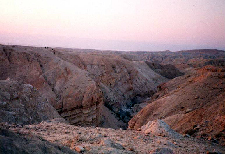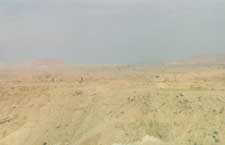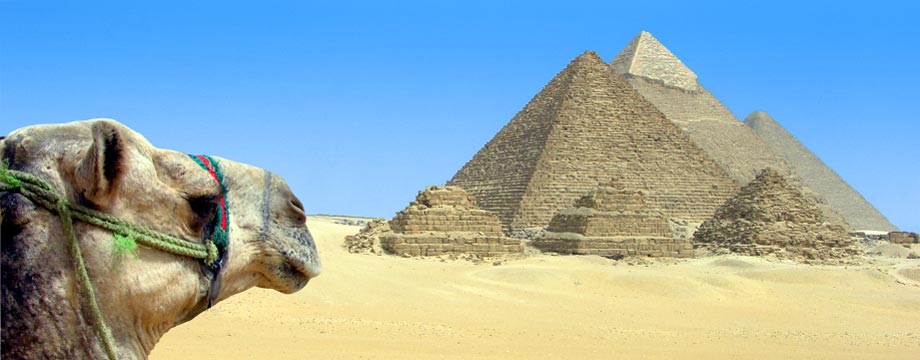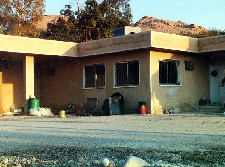Monday, December 13 – Tuesday, December 14, 1999
From Phoenix to Chicago on American Airlines was a 3-hour flight. They checked our bags all the way to Amman. On the way to the international terminal we ran into the principal investigators and their family, and found out that our next flight was delayed 2 hours, so the layover in Chicago stretched to 5 hours.
We left Chicago on a Royal Jordanian Airlines Airbus for Shannon, Ireland, where we landed about 6½ hours later. The flight wasn’t bad, the food decent (“Chicken or beef?”), but Royal Jordanian has yet to ban smoking on its flights. Although there was a smoking section, a blue cloud wafted throughout the aircraft. The layover in Shannon was brief, the air fresh. The final leg was 5 hours to Amman, making about 14½ hours in the air and 6 on the ground, for a total of just over 20 hours of travel.

Twenty Dinar (about $30)
It was slow going through customs, but our Australian friends were waiting with our rides. We made it to the American Center of Oriental Research (ACOR) which is near the University of Jordan. Except for lacking potable water, ACOR has pretty decent facilities. Oh, yeah, and the toilets don’t take toilet paper. There are bins for that. But otherwise ACOR looks pretty good. I’m rooming with the Australians for the next couple of nights until we move to the field. The plan is to use tomorrow to take care of loose ends; then we move to the dig house for the first field school at Mazraa’ by the Dead Sea and get it in shape before the students arrive.
Wednesday, December 15, 1999
We went to the Hiway Stores, owned by a Mr. Basha, for $425 worth of groceries. The store sported a fifteen foot high statue of Mickey Mouse out front, presumably unlicensed. Abu Sami, who will be our cook at Mazraa’, came along. Abu Sami is about 80 years old, and has a lot of experience cooking for archaeologists. He learned the culinary arts as a cook for the British Army. He’s also a proud new father. After grocery shopping, we went to a money exchange and got some Jordanian dinar.
Called the States to let the family know I had arrived safely. The telephone system is first rate, and calls to the States can be made from any corner telephone booth. Plenty of internet cafes, too, but that may be because we’re so close to the university. The big meal of the day at ACOR is lunch, and it was fabulous. I’ve heard that the cook here is much coveted and has turned down other jobs to work here.
Thursday, December 16, 1999
We left ACOR with the truck loaded up like the Beverly Hillbillies. Cynthia, Ilya and I made a few stops for supplies on the way. Although it’s winter and cold here in Amman, down by the Dead Sea we’re expecting warmer temperatures, so we thought it would be a good idea to buy fly paper. Couldn’t find any fly paper anywhere. In one store the owner responded to my request with: “Fly paper? It isn’t fly season. It’s rat season!”
We made it to Mazraa’ in less than 2 hours, and it much warmer here at the lower altitude. It was a beautiful day and felt like spring. The dig house is a sprawling one story, run down, with no hot water, and fly infested. It sits within a government compound that houses various officials with business in the district. Abu Sami lived up to his billing. Food was great.
We set to work cleaning and fixing up while Ilya took the truck to borrow a dining room set from another dig. The truck broke down, so assistant cook Abu Abed and I retrieved Ilya in Abu Abed’s car.
Friday, December 17, 1999
We drove to the shore of the Dead Sea on the Lisan Peninsula so the geographers with us could check the area where they will be taking cores. Then we went to the site, Zahrat ahd-Dhra.
ZAD is on a ridge between deep wadis. It has surface features and is littered with artifacts. Tough climbs down and then back up. We were followed by two goats, who soon rejoined their flock. A natural bridge is visible from the site.

Abu Abed’s Rescue Car Outside Dig House
The rest of the day was preparing for the students who arrive late tonight. I’m rooming with Ilya and we put up curtains, coat hooks and shelves. We worked on the building’s water system, which seems to defy the laws of physics. We’re leaking so much water that we’re attracting frogs to the building. I got the water filtration system set up, and fired up my own PUR water filter.
Saturday, December 18, 1999

Arriving Crew Descends into the Wadi
Abu Abed and I went to the town of Safi, looking for water heaters and a blacksmith to make screens for use on site sifting. It was a fool’s errand and we came back empty handed, or as Abu Abed said translating the Jordanian idiom from Arabic: “We came back with nothing in our shoes.”
Sunday, December 19, 1999

Guard Tent (right of center) at Zahrat ahd-Dhraa
We took the equipment up to the site, helped by a pampered donkey. There will be a tent and guard on site overnight, so we won’t be hauling equipment up and down daily. We marked the grid and laid out excavation units.
Breakfast is at the dig house at 6 AM. “Second breakfast” is eaten on the site at 10 AM. Lunch is eaten back at the dig house at 2:30 PM and Dinner is at 7 PM. The meals have been vegetarian, mainly due to the lack of reliable sources of meat in the area.
Monday, December 20, 1999
I’m responsible for three students, each of whom has a crew of two Jordanians working for them. The Jordanians are Bedouins, and further identify themselves as “Asazmi.” They are no longer migratory and find work mostly in the tomato and bean fields around the Dead Sea, which is actually well watered with runoff from higher elevations to the east. (Of course, any direction away from the Dead Sea takes you higher.) We’re paying them 4 dinar ($6) a day, which is one dinar a day more than they make in the fields.

Jordanian Crew Members at ZAD
We made good progress on our first day digging. We found a few sherds consistent with the Middle Bronze Age date attributed to the site, and several possible chipped stone lithics.
We got hot water in our room today, and it was just as good as I remembered it.
<- PREV | NEXT ->


